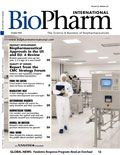Regulatory Challenges Impede the Adoption of New Downstream Processing Technologies
Can vendor-user partnerships overcome the typical wait-and-see attitude toward new technologies?
In virtually any other industry, the adoption of more efficient, less costly production technologies would be rapidly accepted. But not quite so in the biopharmaceutical industry, where concerns over regulatory acceptance and approval delays prevail.

Eric Langer
So in this industry, with its built-in inertia, new technology introductions can be tough. Investors expecting rapid returns on product innovations used in clinical or commercial therapeutic production can be quickly disappointed. Downstream processing, the bottleneck that everyone wants a solution for, is a prime example. In previous columns, we've discussed various technologies being developed to address this bottleneck, but we haven't addressed the strategies behind getting these new technologies into the market.
Preliminary data from BioPlan Associates' 7th Annual Report and Survey of Biopharmaceutical Manufacturing Capacity and Production clearly indicates that little has changed over the past seven years regarding solutions to address the downstream bottleneck. Many new technologies are under investigation, but these are being "actively considered" and not actively implemented. Many end users want to see new technology improvements used to manufacture a product approved by the FDA, but until this happens, regulatory challenges will continue to overshadow the benefits of reduced costs, fewer steps, more purification cycles, and disposability.
REGULATORY CHALLENGES
To get a sense of where the trends are heading, we spoke to our Biotechnology Industry Council panel on downstream processing regarding regulatory hurdles. Their feedback is presented below.
Most Critical Downstream Regulatory Issues
- Managing characterization, robustness, and scalability: The biggest concerns continue to be proving that leachables a) are not present, b) can be cleared, or c) do not affect product quality, especially with single-use devices and separations media, membranes, and filter housings.
- Scalability of membrane chromatography: Today, membrane chromatography beyond around 5 L is scaled up by adding devices in parallel or series. Regulatory concerns include the scalability of membrane-based processes, flow distribution, and device variability.
- Perception that membranes are more variable than chromatography resins: Manufacturers need to prove that processes are insensitive to lot-to-lot variation of membrane adsorbers.
- Comparability of product quality: The industry needs to understand the impact of new technologies on product quality, compared with traditional technologies.
- Working closely with vendors: Developers must work closely with vendors to address testing hurdles.
Regulatory Approach to New Technologies
- Wait and see: As with any new technology, the industry will wait to see how early adopters succeed. Industry groups like the Bio-Process Systems Alliance can help by pushing for standardized test methods.
- Comparisons with Current Technologies: Regulatory approaches will depend on how new technologies compare with established processes. Implementation of new technologies will be accepted when appropriate data are presented in regulatory filings.
- Emphasis on Quality by Design: For regulatory filings, understanding the operational aspects of any novel downstream technologies is critical. Such is not the case with many new technologies.
INDUSTRY PERSPECTIVE
Being a first-adopter in this industry requires balancing the regulatory risk against the benefits of being first to integrate a new technology. According to our survey and our panel of experts, the industry continues its wait-and-see attitude. The problem is how receptive the FDA will continue to be to novel alternatives to chromatography. "When more single-use purification technologies start to penetrate the market, you'll also see increased focus on characterizing and managing robustness and scalability," says, Michael Kuczewski, scientist I, downstream process development, Percivia, LLC.
Others believe the FDA has already indicated a receptive attitude. Justin McCue, head engineer, bioprocess development at Biogen Idec says, "Membrane adsorbers have been readily accepted. One of the keys to acceptance is to ensure appropriate in-process controls and tests are established for alternative technologies." Acceptance, according to Amitava Kundu, associate director, process development, Genmab, Inc., is a function of comparability of processes, which "must be accompanied by an ability to probe for changes in secondary and tertiary structure of the protein as well as an ability to further understand and monitor the presence of large aggregates … that could potentially be created in the process."
A key problem in the approval process, says John Zeng, head of purification R&D at Lonza Biologics, will require that vendors and end-users work together to tackle problems such as the testing associated with new materials, matrices, and formats, "Developers need to work closely with vendors to overcome this hurdle by more testing," he said. Zeng believes that the first ones will take the biggest risk. However, given the merits of novel downstream technologies to improve selectivity, binding capacity, and throughput, the regulatory pathway should become relatively easier as agencies take a more positive approach to alternatives to chromatography.
CONCLUSIONS
The industry is asking for solutions that include clearer guidance from regulators and more partnering with vendors and industry associations to address the downstream bottleneck.
Being first in the water may be a challenge for new technology adoption, and before broad acceptance of novel downstream technologies take place, the industry will need to move forward to get to those early adopter success models.
Eric Langer is president and managing partner at BioPlan Associates, Inc., Rockville, MD. He also is the editor of Advances in Large-scale Biopharmaceutical Manufacturing, 301.921.5979, elanger@bioplanassociates.com
